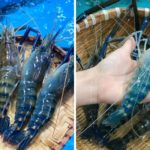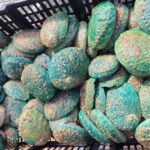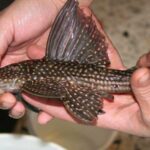Fish is a staple in the diets of many families around the world, and for good reason. Not only is it a great source of nutrients, but it’s also a versatile ingredient that can be prepared in a myriad of mouth-watering ways. Among the myriad of fish available in the market today, from river fish to marine varieties, the catfish family holds a special place in the hearts (and kitchens!) of homemakers, especially in Vietnam.
1 Unveiling the Pangasius Catfish
The Pangasius catfish, a member of the Siluriformes order (aka catfish family), is native to freshwater environments and can also adapt to brackish waters. This catfish stands out with its thick body and relatively small head, complemented by two pairs of rather long whiskers, one on the upper jaw and the other on the chin.
The Mekong River is the natural habitat of the Pangasius catfish, and they are predominantly farmed in the Mekong Delta region of Vietnam, contributing significantly to the local economy.
 The Pangasius catfish, a member of the Siluriformes order, is native to freshwater environments.
The Pangasius catfish, a member of the Siluriformes order, is native to freshwater environments.
2 Introducing the Basa Fish
The Basa fish, with the scientific name Pangasius bocourti, is also known by several other names, including swai, belly pangasius, or bocourti whiting. Much like its cousin, the Pangasius catfish, it belongs to the Siluriformes order. The Basa fish is a commercially valuable species, providing a significant source of income for the people of the Mekong Delta region.
The Basa fish is characterized by its slightly flattened body, particularly at the tail, with a rounded belly and a greenish-gray back, complemented by a whitish-gray belly. This fish thrives in freshwater environments and is a farmer’s friend due to its ease of farming, impressive reproductive rates, and rapid growth in natural conditions.
 The Basa fish, also known as swai, boasts a slightly flattened body with a greenish-gray back.
The Basa fish, also known as swai, boasts a slightly flattened body with a greenish-gray back.
3 Telling Them Apart: Pangasius Catfish vs. Basa Fish
Within the expansive catfish family, the Pangasius catfish and Basa fish are often mistaken for each other due to their similar appearances. To ensure consumers don’t fall prey to mislabeling and accidental purchases, this article will arm you with tips to distinguish between these two slippery customers.
Head Shape: The First Clue
 The Pangasius catfish sports a more prominent head that spreads out to the sides.
The Pangasius catfish sports a more prominent head that spreads out to the sides.
The Basa fish, on the other hand, has a short head that is vertically flattened. The depression between its skull bones is shallow and narrow but long, and its mouth is slightly offset from its eyes. Additionally, the upper jaw boasts a wide band of teeth that remain visible even when the mouth is closed.
In contrast, the Pangasius catfish presents a larger, bulkier head that is horizontally flattened. The depression between its skull bones is deeper and wider but shorter, concealing the teeth when the mouth is closed.
Whisker Length: Another Telling Sign
 The Basa fish displays unequal whisker lengths, with the upper jaw whisker being shorter.
The Basa fish displays unequal whisker lengths, with the upper jaw whisker being shorter.
While all Pangasius catfish have two pairs of whiskers, the length varies between species. The Basa fish has a distinctive whisker on the upper jaw that is approximately half the length of its head, while the lower jaw whisker reaches only a third of the head’s length.
Conversely, the Pangasius catfish flaunts longer whiskers that extend from the eye to the gill, with equal lengths on the upper and lower jaws.
Body Shape: A Distinct Difference
 The Basa fish boasts a large, rounded belly, while the Pangasius catfish has a smaller, silvery belly.
The Basa fish boasts a large, rounded belly, while the Pangasius catfish has a smaller, silvery belly.
Another distinguishing feature lies in their body shape. The Basa fish has a short body that is flattened on both sides, accompanied by a large, rounded belly. Its dorsal surface takes on a light greenish-brown hue, while the ventral surface is white.
When you hold a Pangasius catfish, you’ll notice a silvery shine on its dorsal surface. This fish has a longer body with a smaller belly, and its dorsal surface leans towards a darker shade of green.
A Peek Inside: Examining the Flesh
 The Basa fish is known for its fine, white flesh and white fat.
The Basa fish is known for its fine, white flesh and white fat.
When you cut into a Basa fish, you’ll discover small, fine, and white flesh. Its large, rounded belly, when opened, reveals two lobes of fat resembling grapefruit segments, tinted with a whitish color.
In contrast, the Pangasius catfish presents larger flesh fibers with a subtle pinkish hue. Its fat is not white; for those raised in cages, the fat takes on a yellow color but emits a strong odor. If not properly prepared, this odor can become more noticeable.
4 Price Comparison: Basa Fish vs. Pangasius Catfish
The farming processes for these two fish vary, impacting their pricing. Basa fish are predominantly farmed upstream, and the process takes around six months. On the other hand, Pangasius catfish can be farmed downstream, reducing the farming process to about four months. Consequently, basa fish are slightly more expensive, currently priced at approximately 50,000 VND/kg, while Pangasius catfish are more affordable at around 30,000 VND/kg.
Due to the higher price point of basa fish and the challenge of distinguishing between the two species when sliced, some traders have been known to mislabel them, leading to consumer confusion. Both varieties are delectable and packed with nutrients, but accidentally buying the wrong type can be frustrating. With the insights shared above, homemakers can now confidently differentiate between these two members of the catfish family and make informed purchases.
 Basa fish and Pangasius catfish have notable price differences, with basa fish being more expensive.
Basa fish and Pangasius catfish have notable price differences, with basa fish being more expensive.
5 Culinary Creations with Basa Fish
Basa fish is a culinary delight, offering not just delicious flavors but also a host of nutrients. Its thick, fatty, and tender meat adds a unique touch to any dish it graces.
One of the standout features of basa fish is its high meat content and low bone content, making it incredibly versatile and easy to work with in the kitchen. Here are some mouthwatering dishes you can create with this fantastic fish:
Sour and Spicy Basa Fish Soup
 Sour and Spicy Basa Fish Soup: A Flavor Explosion.
Sour and Spicy Basa Fish Soup: A Flavor Explosion.
Braised Basa Fish: A Hearty Delight
 Braised Basa Fish: Tender and Flavorful.
Braised Basa Fish: Tender and Flavorful.
Sweet and Sour Braised Basa Fish: A Tangy Treat
 Sweet and Sour Braised Basa Fish: A Perfect Balance of Flavors.
Sweet and Sour Braised Basa Fish: A Perfect Balance of Flavors.
6 Delicious Dishes Starring Pangasius Catfish
Pangasius catfish boasts thick and firm meat, making it an excellent choice for a variety of dishes. Whether you’re craving a hot pot, grilled fish in banana leaf, or pickled fish rolls, this versatile fish delivers. Here are some delectable dishes to showcase its potential:
Sour and Spicy Pangasius Catfish Soup: A Flavorful Adventure
Pickled Pangasius Catfish: A Tangy Treat
 Pickled Pangasius Catfish: A Delicious, Tangy Dish.
Pickled Pangasius Catfish: A Delicious, Tangy Dish.
Mildly Braised Pangasius Catfish: Tender and Subtle
 Mildly Braised Pangasius Catfish: A Delicate, Flavorful Dish.
Mildly Braised Pangasius Catfish: A Delicate, Flavorful Dish.
The Rise of Livestream Shopping: Unlocking the Secrets to its Success in 2023
The rise of livestream shopping has taken the world by storm, with an influx of savvy livestreamers and jaw-dropping deals from luxury brands alike. This new era of online shopping has revolutionized the way consumers engage with brands and products, creating an immersive and exciting experience like no other. With the simple click of a button, shoppers are transported into a vibrant and dynamic world, where they can interact, ask questions, and make purchases in real-time. The thrill of securing exclusive deals and the convenience of having products showcased in the comfort of their homes have captivated audiences, making livestream shopping a phenomenon that is here to stay.
What is the Windowpane Fish? Delicious Dishes From Windowpane Fish.
Join us today as we dive into the world of the fascinating glass catfish! Learn about their unique characteristics and discover the delicious culinary delights that can be created with this special fish. Uncover the secrets of this incredible creature and explore the wonders it can bring to your plate. Stay tuned, as we take you on a flavorful journey like no other!









































